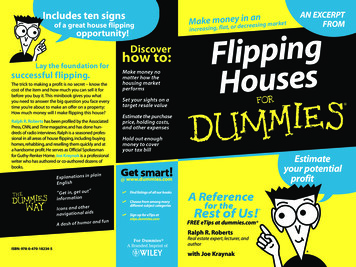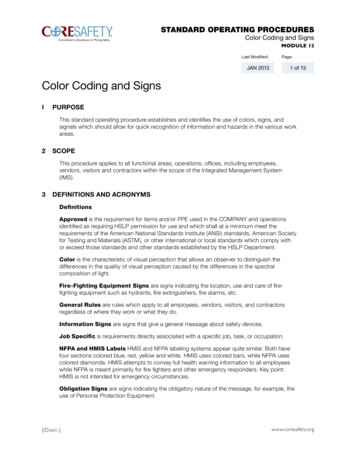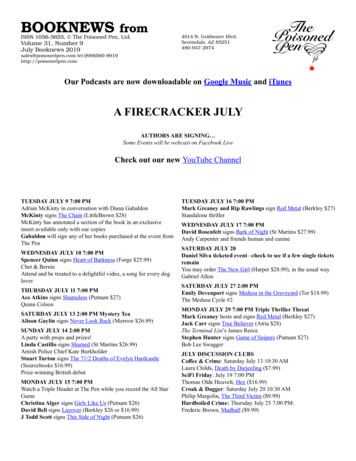
Transcription
Includes ten signsof a great house flippingopportunity!Lay the foundation forsuccessful flipping.The trick to making a profit is no secret – know thecost of the item and how much you can sell it forbefore you buy it. This minibook gives you whatyou need to answer the big question you face everytime you’re about to make an offer on a property:How much money will I make flipping this house?Ralph R. Roberts has been profiled by the AssociatedPress, CNN, and Time magazine, and has done hundreds of radio interviews. Ralph is a seasoned professional in all areas of house flipping, including buyinghomes, rehabbing, and reselling them quickly and ata handsome profit. He serves as Official Spokesmanfor Guthy-Renker Home. Joe Kraynak is a professionalwriter who has authored or co-authored dozens ofbooks.Make money nomatter how thehousing marketperformsSet your sights on atarget resale valueanMake mont, eorydeincreasing marketincreasing, flaFlippingHousesEstimate the purchaseprice, holding costs,and other expensesHold out enoughmoney to coveryour tax billEstimateyour potentialprofitinExplanations in plaEnglish“Get in, get out”informationIcons and othernavigational aidsand funA dash of humor Find listings of all our books Choose from among manydifferent subject categories Sign up for eTips atetips.dummies.comFREE eTips at dummies.com Ralph R. RobertsISBN: 978-0-470-18234-5AN EXCERPTFROMReal estate expert, lecturer, andauthorwith Joe Kraynak
When you are ready for more details on flipping houses, pickup a copy of Flipping Houses For Dummies. Flipping Houses ForDummies reveals the risks and rewards of flipping properties;helps you determine whether you have the time, energy, cash,and other resources to be successful; and then conveys theexpert knowledge that those who wish to pursue house flipping need in order to minimize risk and maximize potentialprofits in a very competitive market.Flipping Houses For Dummies978-0-470-04345-5GetFlipping.comBefore you lay down your hard-earned cash on that investmentproperty you’ve had an eye on, fire up your computer and head outto GetFlipping.com. This exciting new Web site, compliments of Ralph R.Roberts, introduces you to the exciting world of flipping houses. Here,you get a taste of what Flipping Houses For Dummies is all about. Check out the flipping tip of the day. Read a real-life story of a property Ralph flipped. View additional before-and-after photos. Sign up for Ralph’s free 31-day house flipping course! Discover the most critical risks and pitfalls to avoid. Tap the power of Ralph’s automated Purchase Price Estimator!Get Flipping at GetFlipping.com today!—Ralph R. Roberts, author of Flipping Houses For DummiesOfficial Spokesperson for Guthy-Renker HomeAvailable wherever books are sold or visit dummies.com
01 182345 fm.qxp5/8/075:48 PMPage iCopyrighted Material - John Wiley & Sons, Inc.Excerpt fromFlipping HousesFORDUMMIES‰by Ralph R. Robertswith Joe KraynakAuthors of Flipping Houses For Dummies
01 182345 fm.qxp5/8/075:48 PMPage iiCopyrightedMaterial - John Wiley & Sons, Inc.Excerpt from Flipping Houses For Dummies Published byWiley Publishing, Inc.111 River StreetHoboken, NJ 07030-5774Copyright 2007 by Wiley Publishing, Inc., Indianapolis, IndianaPublished by Wiley Publishing, Inc., Indianapolis, IndianaNo part of this publication may be reproduced, stored in a retrieval system ortransmitted in any form or by any means, electronic, mechanical, photocopying,recording, scanning or otherwise, except as permitted under Sections 107 or 108 ofthe 1976 United States Copyright Act, without the prior written permission of thePublisher. Requests to the Publisher for permission should be addressed to theLegal Department, Wiley Publishing, Inc., 10475 Crosspoint Blvd., Indianapolis, IN46256, (317) 572-3447, fax (317) 572-4355, or online at www.wiley.com/go/permissions.Trademarks: Wiley, the Wiley Publishing logo, For Dummies, the Dummies Manlogo, A Reference for the Rest of Us!, The Dummies Way, Dummies Daily, The Funand Easy Way, Dummies.com, and related trade dress are trademarks or registeredtrademarks of John Wiley & Sons, Inc. and/or its affiliates in the United States andother countries, and may not be used without written permission. All other trademarks are the property of their respective owners. Wiley Publishing, Inc., is notassociated with any product or vendor mentioned in this book.LIMIT OF LIABILITY/DISCLAIMER OF WARRANTY: THE PUBLISHER AND THE AUTHOR MAKE NOREPRESENTATIONS OR WARRANTIES WITH RESPECT TO THE ACCURACY OR COMPLETENESSOF THE CONTENTS OF THIS WORK AND SPECIFICALLY DISCLAIM ALL WARRANTIES, INCLUDINGWITHOUT LIMITATION WARRANTIES OF FITNESS FOR A PARTICULAR PURPOSE. NO WARRANTYMAY BE CREATED OR EXTENDED BY SALES OR PROMOTIONAL MATERIALS. THE ADVICE ANDSTRATEGIES CONTAINED HEREIN MAY NOT BE SUITABLE FOR EVERY SITUATION. THIS WORKIS SOLD WITH THE UNDERSTANDING THAT THE PUBLISHER IS NOT ENGAGED IN RENDERINGLEGAL, ACCOUNTING, OR OTHER PROFESSIONAL SERVICES. IF PROFESSIONAL ASSISTANCE ISREQUIRED, THE SERVICES OF A COMPETENT PROFESSIONAL PERSON SHOULD BE SOUGHT.NEITHER THE PUBLISHER NOR THE AUTHOR SHALL BE LIABLE FOR DAMAGES ARISING HEREFROM. THE FACT THAT AN ORGANIZATION OR WEBSITE IS REFERRED TO IN THIS WORK ASA CITATION AND/OR A POTENTIAL SOURCE OF FURTHER INFORMATION DOES NOT MEANTHAT THE AUTHOR OR THE PUBLISHER ENDORSES THE INFORMATION THE ORGANIZATIONOR WEBSITE MAY PROVIDE OR RECOMMENDATIONS IT MAY MAKE. FURTHER, READERSSHOULD BE AWARE THAT INTERNET WEBSITES LISTED IN THIS WORK MAY HAVE CHANGEDOR DISAPPEARED BETWEEN WHEN THIS WORK WAS WRITTEN AND WHEN IT IS READ.For general information on our other products and services, please contact ourCustomer Care Department within the U.S. at 800-762-2974, outside the U.S. at317-572-3993, or fax 317-572-4002. For details on how to create a custom ForDummies book for your business or organization, contact bizdev@wiley.com.For information about licensing the For Dummies brand for products or services,contact BrandedRights&Licenses@Wiley.com.ISBN: 978-0-470-18234-5Manufactured in the United States of America10 9 8 7 6 5 4 3 2 1
02 182345 ch05.qxp5/8/075:49 PMPage 1Copyrighted Material - John Wiley & Sons, Inc.Chapter 5Guesstimating YourPotential ProfitIn This Chapter Making money no matter how the housing marketperforms Setting your sights on a target resale value Estimating the purchase price, holding costs, andother expenses Ballparking your potential gross profit Holding out enough money to cover your tax billWhether you’re dealing in antiques, collectibles,or houses, the trick to making a profit is nosecret — know the cost of the item and how much youcan sell it for before you buy it.When you’re flipping houses, the formula becomes alittle more complex. You should have a pretty goodestimate of how much you can get for the house afterimprovements, and then subtract the purchase price ofthe house and all expenses related to buying, owning,
02 182345 ch05.qxp5/8/075:49 PMPage 2Copyrighted Material - John Wiley & Sons, Inc.2rehabbing, marketing, and selling the property. Thechunk of change that remains is your gross profit — inIRS parlance, your capital gains or in some cases yourordinary income. Subtract any taxes due, and the rest isyours to keep . . . or invest in your next house flippingventure.This chapter gives you what you need to answer thebig question you face every time you’re about to makean offer on a property: How much money will I makeflipping this house?Knowledge is power. Only by knowing howmuch you can get for the house, how much itcosts, and how much fixing it up and selling itcosts can you determine whether the purchase is worth your investment of money,time, and aggravation. Flipping Houses ForDummies has more information to help yougauge whether flipping is right for you.Making Money in Any MarketThe housing market, like the stock market,fluctuates. Home values can steam ahead, stayput, or spiral down out of control. You makeyour money when you buy a house at lessthan market value. By adjusting your purchaseprice based on market conditions, thus lowering your total investment in a property, youcan make money in any market. The followinglist offers some general guidelines for gaugingyour total investment in the three main typesof housing markets:
02 182345 ch05.qxp5/8/075:49 PMPage 3Copyrighted Material - John Wiley & Sons, Inc.3 Increasing: When home values are rising, yourtotal investment in the property, including thepurchase price, closing costs, renovation costs,holding costs, and selling costs, shouldn’t exceed80 percent of its estimated resale value (I coverresale values later in this chapter). Flat: When home values are steady, limit yourtotal investment in the property to 70 to 75 percent of the estimated resale value. Decreasing: When homes in the area are decreasing in value, invest no more than 60 to 65 percentof the property’s estimated resale value.For example, to flip a house you expect to sell for 200,000 in a flat market, you may buy the house for 120,000, spend 20,000 fixing it up, and use 10,000for other expenses (such as mortgage payments, insurance, utilities, selling costs, and unexpected bills).Your total investment is 150,000, which is 75 percentof the estimated resale value. In an increasing market,you can invest a maximum of 160,000 (80 percent of 200,000) in the property. In a decreasing market, youcan invest a maximum of only 130,000 (65 percent of 200,000) in the property. After you decide how muchyou can afford to invest overall, adjust the purchaseprice accordingly. Don’t expect to make up the difference in your other expenses (including renovation andholding costs).On their surface, these numbers suggest that you standto make more in a declining market. You invest a maximum of 130,000 in the hopes of selling the house for 200,000, but in a declining market, you can’t count on
02 182345 ch05.qxp5/8/075:49 PMPage 4Copyrighted Material - John Wiley & Sons, Inc.4selling the house for 200,000. You may have to dropthe price to 180,000 or less to price it competitively.By adjusting the total investment down in a downmarket, you simply reduce your exposure to risk.In any market, you want to earn at least a20 percent profit for your time and effort.Don’t let a slow market slow you down. If yousee a gaggle of homes for sale with recentlyreduced asking prices, the market in that particular neighborhood may be starting to soften.This softening may signal a great buyingopportunity, but you need to re-evaluate yourresale estimate as well. Head to the full version of Flipping Houses For Dummies for moredetails on determining the type of real estatemarket that any given neighborhood is in.Ballparking a RealisticResale ValueYou start house hunting by looking at neighborhoodsand houses in your price range (see the full version ofFlipping Houses For Dummies for the scoop on househunting). When you’re guesstimating profits, though, youstart your journey at the end by determining a realisticballpark figure for the home’s resale value after improvements. The key term here is realistic. Overestimating theresale value of the house can be as devastating as discovering termites in the floorboards; it can cause you tooverpay for a house and almost guarantee a financialfiasco.
02 182345 ch05.qxp5/8/075:49 PMPage 5Copyrighted Material - John Wiley & Sons, Inc.5To estimate a realistic resale value for a house,imagine the house all fixed up and thenresearch the actual sales prices of comparablehomes that have recently sold in the sameneighborhood. Assuming that you’re comparing apples to apples — this house tocomparable homes in the same area with thesame amenities — you should come awaywith an accurate estimate. What if the markettakes a nose dive? By following the guidelinesin the previous section, you’re already takinginto account potential market fluctuations.Your goal as a house flipper is to purchase theworst house on the street for the lowest pricepossible and convert it into the best-lookinghouse on the street at the highest price themarket can bear. Anything you can do to addWOW to the home, especially in terms of curbside appeal, can boost your bottom line.Estimating the resale value of a house can betricky, because you may not know what you’regetting into until you take possession. Houseshave histories, and dramatic events, such asmurders, suicides, and drug busts can give ahouse a bad rep, making it a tough sell. Theonly way to battle back is to shake off any ofyour own superstitions right away and put apositive spin on the property. Superstitions, asdemonstrated in the nearby sidebar, can getinto your head, muddle your thinking, andslash your bottom line.
02 182345 ch05.qxp5/8/075:49 PMPage 6Copyrighted Material - John Wiley & Sons, Inc.6Devilish devaluationsWhen you purchase a property, you get much more than a lot witha house on it — you get neighbors. I once purchased a homeat a sheriff’s sale and waited patiently through the redemptionperiod, only to discover during the possession process that thehouse was haunted, and the local gossipmonger was determined to keep all passersby well informed.The next-door neighbor wasn’t about to relinquish her reporting job after I took possession. In fact, she stepped up herefforts to broadcast the news to anyone and everyone wholooked at the house. Her intrusions completely undermined mymarketing and sales efforts.If this sort of intrusion happens to you, nip it in the bud. Betteryet, become proactive in establishing positive relationships withyour neighbors. Let them know that your intention is to rehabthe property and improve the neighborhood, which ultimatelyincreases the value of their homes. Invite your neighbors overfor an open house, make light of any nasty rumors, and use theopportunity to highlight the main features of the house. In addition to helping you sell the home, positive neighbor relationships often generate future leads.Subtracting the Purchase Priceand Closing CostsYour biggest financial outlay in any house flipis the cost of acquiring the property — thepurchase price and closing costs. Fortunately,these are the two items over which you havethe most control. You’re always free to walk
02 182345 ch05.qxp5/8/075:49 PMPage 7Copyrighted Material - John Wiley & Sons, Inc.7away from a deal if the price exceeds yourbudget, and you can often negotiate to havethe seller pay a portion of the closing costs.Your maximum purchase price depends on severalfactors, including the estimated sales price, cost ofrenovations, and holding costs. When you completethe Profit Projector in the later section “Ka-Ching!Projecting Your Potential Gross Profit,” you can tellimmediately whether the purchase price is too high foryour budget, and you can adjust your offer accordingly.For now, you can determine a ballpark maximum purchase price by completing the following formula:Estimated Sales Price:Closing Costs: - Renovation Costs:- Holding Costs:- Costs to Sell:- Maximum Purchase Price: Set a minimum offer and maximum purchaseprice. Use the maximum purchase price inyour calculations to give yourself additionalwiggle room.Next, subtract the estimated closing costs. Your realestate agent, lending institution, or title company canprovide a detailed estimate of closing costs, which, ifyou’re taking out a loan to finance the purchase, typically include the following items: Loan origination fee: If you finance the purchasethrough a bank or other lending institution, it maycharge a fee for establishing the loan. (See the full
02 182345 ch05.qxp5/8/075:49 PMPage 8Copyrighted Material - John Wiley & Sons, Inc.8version of Flipping Houses For Dummies for moredetails about financing your purchase.) Discount points: Some lending institutions chargediscount points — a percentage of the total amountborrowed — to provide you with a lower interestrate or wring another few hundred (or thousand)bucks out of you.Avoid loans with discount points. You usuallyhave to hold a property for several years tojustify the monthly savings, and when you’reflipping houses, holding a property for several years isn’t your goal. Appraisal fee: The lending institution chargesyou this fee to have an appraiser ensure that theproperty is worth at least the amount you’re borrowing to purchase it. Title insurance: Even if you researched the title orhired a title company to do it for you (see theparent version of Flipping Houses For Dummies),the bank may require that you pay for title insurance or a mortgage policy (sometimes called amortgagee policy). Insurance and taxes: If you take out a loan thatrequires you to pay taxes and insurance out of anescrow account, you may need to pay a proratedshare of insurance and taxes upfront. Deed recording fee: Whenever a propertychanges hands, the name on the deed changesand must be recorded. Yes, you’re charged forthis, too.
02 182345 ch05.qxp5/8/075:49 PMPage 9Copyrighted Material - John Wiley & Sons, Inc.9 Credit report charge: The lending institutiondoes a financial background check on you called acredit report and then charges you for the privilege. Closing fee: The title company typically chargesa closing fee.Most closing costs originate with the bank orother lending institution. By financing thepurchase through the seller or with moneyfrom private investors, partners, friends, orfamily members, you can trim closing costsconsiderably.Subtracting the Cost of Repairsand RenovationsEager house flippers often underestimate the cost ofrepairs and renovations. They’re so enthusiastic aboutpurchasing the house, selling it, and counting theirmoney that they forget how much a carpenter orplumber charges per hour and the cost of materials atthe local hardware store. Repairs and renovations arecostly, and if you wait until you take possession of thehouse before obtaining estimates, you’re already too late.If you’re still interested in a house after youtake a quick tour of it, do a second, more thorough inspection of the premises to determinethe repairs and renovations you want to make.(See the full version of Flipping Houses ForDummies for details on the process of inspecting a potential flip.) List all the repairs and
02 182345 ch05.qxp5/8/075:49 PMPage 10Copyrighted Material - John Wiley & Sons, Inc.10improvements needed to bring the property inline with your projected resale price (whichwe cover earlier in this chapter). Estimate thecost of repairs by doing the following: Flag any repairs you can do yourself. These arezero-labor repairs, but you may need to visityour local hardware store to check out pricesfor materials. Ask a member of your team who has more experience with construction projects to walk throughthe house with you and offer estimates and advice.(See Flipping Houses For Dummies for details onbuilding your flipping team.) To prevent the negativity of naysayers from undermining your vision,keep in mind that you’re taking the risk and makingthe final decisions. Call one or two local contractors to obtain ballpark estimates for any repairs or improvementsyou can’t do yourself. You may be able to hire ageneral contractor to walk through the house withyou and provide a professional opinion.If you can’t look at the wiring in a house andcome up with a pretty good guess at what itwould cost to bring it up to code, you’d betterconsult somebody who can. Research estimated costs online. Contractors.comat www.contractors.com features a tool forestimating the costs of bathroom and kitchenrenovations, room additions, decks, roofs, andother improvements. LetsRenovate.com at www.
02 182345 ch05.qxp5/8/075:49 PMPage 11Copyrighted Material - John Wiley & Sons, Inc.11letsrenovate.com offers a toolbox packed withcalculators for estimating the costs of repairs andrenovations and the return you can expect onyour investment.Tally the estimated costs of repairs and renovationsand multiply the total by 1.2 to add 20 percent for unexpected expenses.You can trim the costs of repairs and renovations inseveral ways: Trade your services for free labor. Bartering (ortrading services) may have tax consequences, socheck with your accountant. Do some of the labor-intensive work yourself. Negotiate with the property owner to share thecosts.The full version of Flipping Houses For Dummies hasmore details on planning and prioritizing your renovations, including tips on tagging do-it-yourself projectsand knowing when to hire professionals for certaintasks. The book also is full of great tips on cutting yourrenovation costs.Subtracting Your Holding CostsAs a homeowner, you’re well aware of the monthly costsof owning a home, but when you first begin flippingproperties, you tend to overlook the monthly expensesof holding onto the property, such as your house payment, homeowner’s insurance, and property taxes.
02 182345 ch05.qxp5/8/075:49 PMPage 12Copyrighted Material - John Wiley & Sons, Inc.12Reality hits after you’ve owned the property for four orfive months and begin running out of cash. By then,your 20/20 hindsight leads only to panic and despair.To keep the property, you need money to pay the mortgage, property taxes, and insurance. And if you plan onusing any power tools on the premises, you’d betterpay your electric bill, too (in addition to other utilities).If you’re using the home you’re flipping asyour primary residence, you can safely skipthis section. For you, holding costs are actually living expenses — the normal amounts youpay to have a roof over your head.A great way to project holding costs is toassume, on average, an amount of 100 a day.This amount works for most houses and provides for any surprises along the way. If ittakes you a total of six months to flip a property (including rehab and resale time), totalclosing costs would break down as follows: 100 per day 6 months 30 days per month 180 days 180 days 100 per day 18,000 (in other words, 3,000 per month)Of course, holding costs vary depending on several factors. To establish a more accurate estimate of yourmonthly holding costs, add your total estimatedmonthly bills for each of the following items: Loan payments: Mortgage payments and payments on any home equity loans you used tofinance renovations comprise a significant chunkof your monthly holding costs.
02 182345 ch05.qxp5/8/075:49 PMPage 13Copyrighted Material - John Wiley & Sons, Inc.13 Homeowner’s insurance: Ask your insuranceagent for a quote and explain your plans, including whether or not you plan on living in the house,to properly insure the property. (A typical homeowner’s policy allows for a home to be vacantonly a certain number of days.) Property taxes: Set aside enough money permonth to pay the property taxes when they’redue. If you pay property taxes out of an escrowaccount, this amount may already be part of yourmortgage payment. Utilities: Gas, electric, water, sewer, and trashbills are all part of your monthly holding costs.The seller should be able to provide averages forlast year’s bills. Neighborhood association fees: You may prepaythese fees at closing and chalk them up as part ofyour closing fees, but if that’s not the case, besure to include them (if applicable) as part of yourmonthly fees. Maintenance: If you pay somebody for mowingthe lawn, watching the house, and letting realestate agents inside to show the home, includethis amount as part of your holding costs.Err on the safe side. Budget sufficient funds tohold the house for three to six months beyondthe date on which you expect to place thehouse back on the market. Few experiencesare more demoralizing than renovating ahouse and then losing it in foreclosurebecause you underestimated your holdingcosts and can’t make the monthly payments.
02 182345 ch05.qxp5/8/075:49 PMPage 14Copyrighted Material - John Wiley & Sons, Inc.14Holding costs can be a great motivator in completing the project on schedule. The faster youflip, the less you pay in holding costs.Subtracting the Costof Selling the HouseWhen you place your rehabbed house back onthe market, you incur additional expensesfor marketing the house before you sell it andselling the house when you close the deal.These costs vary depending on whether yousell the home yourself or through a real estateagent: Agent fees: Attempting to sell your home withoutthe help of a real estate agent can backfire, drastically restricting your number of potential buyers.Even if you choose not to use an agent, the agentshired by prospective buyers may not show yourhome unless they can get their 3 percent cut atthe time of sale. Count on paying 3 to 7 percent ofthe sales price in agent fees. If you don’t use anagent, add 250 to 1,000 for attorney fees. Marketing fees: If you choose to sell the homeyourself, you can count on investing 1 to2 percent of your list price in marketing fees.Whether you list your home in the classifieds oron a For Sale By Owner (FSBO) Web site, you payfor advertising. You also need a few bucks for aFor Sale sign and for finger foods for your openhouse.
02 182345 ch05.qxp5/8/075:49 PMPage 15Copyrighted Material - John Wiley & Sons, Inc.15 Home warranty: Supplying a warranty for thehouse can make it an attractive deal while protecting you against any lawsuits in the event thatsome undiscovered defect in the property rearsits ugly head after the sale. If you decide to offer awarranty, budget enough to cover its cost. A typical home warranty costs between 300 and 500. Closing fees: A title company typically managesthe closing and charges 150 or more for the service. Ask your title company for a more specificestimate. Title insurance: Insuring the title ensures thatyou’re not liable for any hidden liens against theproperty. Title insurance can cost hundreds ofdollars, so shop around for the best price andservice. You can trim this cost by asking the sellerto pay for the owner’s policy of title insurance. Deed preparation: The cost of preparing the deedusually goes to the seller and is typically about50 bucks. Transfer tax: Your state, city, or town maylevy a transfer tax on the exchange of property.The amount varies depending on your location,so consult your accountant. Delinquent water bills or tax bills: At closing,you must pay any water bills or tax bills that arein arrears (overdue or unpaid).Don’t list your house while you’re rehabbingit, but feel free to talk to people during thistime and pass out your business cards. If a
02 182345 ch05.qxp5/8/075:49 PMPage 16Copyrighted Material - John Wiley & Sons, Inc.16buyer falls into your lap through your neighborhood contacts, contact a real estate agentor attorney to complete the transaction.Check out Flipping Houses For Dummies formore details about negotiating the sale ofyour rehabbed house.Ka-Ching! Projecting YourPotential Gross ProfitAs you gather estimates for each item related to purchasing, rehabbing, holding, and selling the house,complete the Profit Projector form shown in Figure 5-1.To complete the Profit Projector, jot down the property’s address, its estimated resale price, the maximumprice you can afford to pay for the property (and stillturn a profit), estimated closing costs, the cost ofrepairs, monthly and total holding costs, and the estimated expenses for marketing and selling the house(including agent commissions). These calculationsdetermine your gross profit from which you can subtract your estimated taxes to determine your net profit(see the following section).If your gross profit is less than 20 percent (or25 percent in a flat market or 35 percent in adeclining market) of your total investment inthe property, you may need to lower your purchase price or simply pass on the property.Don’t raise your estimated sales price just tomake the numbers work — this approach hasled to the ruin of many a poor house flipper byleading them into the trap of paying too muchfor a property.
02 182345 ch05.qxp5/8/075:49 PMPage 17Copyrighted Material - John Wiley & Sons, Inc.17Figure 5-1: This Profit Projector is a handy tool to figure outyour potential profit on a flip.
02 182345 ch05.qxp5/8/075:49 PMPage 18Copyrighted Material - John Wiley & Sons, Inc.18After doing the math, estimate the number ofhours you intend to work on the project anddivide that into the projected profit to determine your hourly pay rate. If you can makemore by taking on a second job at a fast-foodrestaurant, this house probably isn’t worth thetime and effort you would put into it. Keeplooking. Repeat the exercise after completingthe project to determine your actual hourlyrate. You may discover that flipping burgers ismore lucrative and less aggravating for youthan flipping houses. . . at least nobody everlost money flipping burgers.Subtracting Uncle Sam’sCut (In Some Cases)to Get Your Net ProfitThe taxes you owe on the profit you makefrom flipping houses are ambiguous at best. Ofcourse, you pay taxes only on the money thatremains after expenses, but the percentageyou owe on your profit varies depending onseveral factors: If you flip your primary residence in which youlived two of the past five years and you earn 250,000 or less ( 500,000 or less for a couple),you walk away with your entire profit scot-free, atleast according to the tax laws that were in effectwhen I was writing this book.
02 182345 ch05.qxp5/8/075:49 PMPage 19Copyrighted Material - John Wiley & Sons, Inc.19 Owning the investment property for at leastone year and one day qualifies your profit as along-term capital gain, taxable at a rate of 15 percent. Long-term is longer than one year plus oneday. Capital gain is whatever you make on the saleof an asset that has increased in value. Owning the investment property for less than oneyear and one day qualifies your profit as a shortterm capital gain, taxable at the rate you normallypay in income tax. If you flip houses f
Flipping Houses For Dummies 978-0-470-04345-5 GetFlipping.com Available wherever books are sold or visit dummies.com Before you lay down your hard-earned cash on that investment property you’ve had an eye on, fire up your computer and head out to GetFlipping.com. This exciting new Web sit










